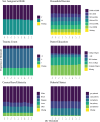Balancing Data Quality and Bias: Investigating Functional Connectivity Exclusions in the Adolescent Brain Cognitive Development℠ (ABCD Study) Across Quality Control Pathways
- PMID: 39788921
- PMCID: PMC11717557
- DOI: 10.1002/hbm.70094
Balancing Data Quality and Bias: Investigating Functional Connectivity Exclusions in the Adolescent Brain Cognitive Development℠ (ABCD Study) Across Quality Control Pathways
Abstract
Analysis of resting state fMRI (rs-fMRI) typically excludes images substantially degraded by subject motion. However, data quality, including degree of motion, relates to a broad set of participant characteristics, particularly in pediatric neuroimaging. Consequently, when planning quality control (QC) procedures researchers must balance data quality concerns against the possibility of biasing results by eliminating data. In order to explore how researcher QC decisions might bias rs-fMRI findings and inform future research design, we investigated how a broad spectrum of participant characteristics in the Adolescent Brain and Cognitive Development (ABCD) study were related to participant inclusion/exclusion across versions of the dataset (the ABCD Community Collection and ABCD Release 4) and QC choices (specifically, motion scrubbing thresholds). Across all these conditions, we found that the odds of a participant's exclusion related to a broad spectrum of behavioral, demographic, and health-related variables, with the consequence that rs-fMRI analyses using these variables are likely to produce biased results. Consequently, we recommend that missing data be formally accounted for when analyzing rs-fMRI data and interpreting results. Our findings demonstrate the urgent need for better data acquisition and analysis techniques which minimize the impact of motion on data quality. Additionally, we strongly recommend including detailed information about quality control in open datasets such as ABCD.
Keywords: ABCD; adolescents; missing data; motion; quality control; rs‐fMRI.
© 2025 The Author(s). Human Brain Mapping published by Wiley Periodicals LLC.
Conflict of interest statement
R.M.B. has consulted with Turing Medical on the development of FIRMM. R.J.H. has served as a consultant for Jazz Pharmaceuticals. No other authors have conflicts of interest to declare.
Figures






Similar articles
-
Advancing motion denoising of multiband resting-state functional connectivity fMRI data.Neuroimage. 2022 Apr 1;249:118907. doi: 10.1016/j.neuroimage.2022.118907. Epub 2022 Jan 13. Neuroimage. 2022. PMID: 35033673 Free PMC article.
-
Typicality of functional connectivity robustly captures motion artifacts in rs-fMRI across datasets, atlases, and preprocessing pipelines.Hum Brain Mapp. 2020 Dec 15;41(18):5325-5340. doi: 10.1002/hbm.25195. Epub 2020 Sep 2. Hum Brain Mapp. 2020. PMID: 32881215 Free PMC article.
-
Youth Screen Media Activity Patterns and Associations With Behavioral Developmental Measures and Resting-state Brain Functional Connectivity.J Am Acad Child Adolesc Psychiatry. 2023 Sep;62(9):1051-1063. doi: 10.1016/j.jaac.2023.02.014. Epub 2023 Mar 22. J Am Acad Child Adolesc Psychiatry. 2023. PMID: 36963562 Free PMC article.
-
Resting-state functional MRI studies on infant brains: A decade of gap-filling efforts.Neuroimage. 2019 Jan 15;185:664-684. doi: 10.1016/j.neuroimage.2018.07.004. Epub 2018 Jul 7. Neuroimage. 2019. PMID: 29990581 Free PMC article. Review.
-
The Adolescent Brain Cognitive Development (ABCD) study: Imaging acquisition across 21 sites.Dev Cogn Neurosci. 2018 Aug;32:43-54. doi: 10.1016/j.dcn.2018.03.001. Epub 2018 Mar 14. Dev Cogn Neurosci. 2018. PMID: 29567376 Free PMC article. Review.
References
-
- Achenbach, T. M. , Dumenci L., and Rescorla L. A.. 2002. “Ten‐Year Comparisons of Problems and Competencies for National Samples of Youth: Self, Parent, and Teacher Reports.” Journal of Emotional and Behavioral Disorders 10, no. 4: 194–203. 10.1177/10634266020100040101. - DOI
-
- Brislin, S. J. , Martz M. E., Joshi S., et al. 2021. “Differentiated Nomological Networks of Internalizing, Externalizing, and the General Factor of Psychopathology ('p Factor’) in Emerging Adolescence in the ABCD Study.” Psychological Medicine 1–11: 3051–3061. 10.1017/S0033291720005103. - DOI - PMC - PubMed
MeSH terms
Grants and funding
LinkOut - more resources
Full Text Sources
Medical

